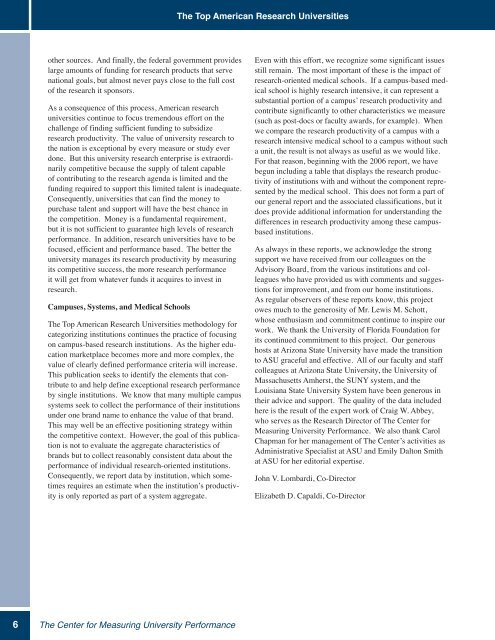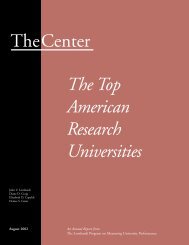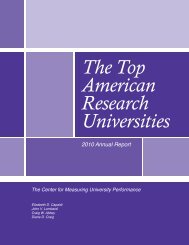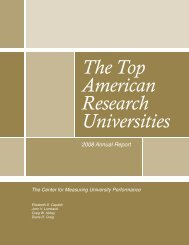2007 Annual Report, (PDF) - The Center for Measuring University ...
2007 Annual Report, (PDF) - The Center for Measuring University ...
2007 Annual Report, (PDF) - The Center for Measuring University ...
- No tags were found...
Create successful ePaper yourself
Turn your PDF publications into a flip-book with our unique Google optimized e-Paper software.
<strong>The</strong> Top American Research Universitiesother sources. And finally, the federal government provideslarge amounts of funding <strong>for</strong> research products that servenational goals, but almost never pays close to the full costof the research it sponsors.As a consequence of this process, American researchuniversities continue to focus tremendous ef<strong>for</strong>t on thechallenge of finding sufficient funding to subsidizeresearch productivity. <strong>The</strong> value of university research tothe nation is exceptional by every measure or study everdone. But this university research enterprise is extraordinarilycompetitive because the supply of talent capableof contributing to the research agenda is limited and thefunding required to support this limited talent is inadequate.Consequently, universities that can find the money topurchase talent and support will have the best chance inthe competition. Money is a fundamental requirement,but it is not sufficient to guarantee high levels of researchper<strong>for</strong>mance. In addition, research universities have to befocused, efficient and per<strong>for</strong>mance based. <strong>The</strong> better theuniversity manages its research productivity by measuringits competitive success, the more research per<strong>for</strong>manceit will get from whatever funds it acquires to invest inresearch.Campuses, Systems, and Medical Schools<strong>The</strong> Top American Research Universities methodology <strong>for</strong>categorizing institutions continues the practice of focusingon campus-based research institutions. As the higher educationmarketplace becomes more and more complex, thevalue of clearly defined per<strong>for</strong>mance criteria will increase.This publication seeks to identify the elements that contributeto and help define exceptional research per<strong>for</strong>manceby single institutions. We know that many multiple campussystems seek to collect the per<strong>for</strong>mance of their institutionsunder one brand name to enhance the value of that brand.This may well be an effective positioning strategy withinthe competitive context. However, the goal of this publicationis not to evaluate the aggregate characteristics ofbrands but to collect reasonably consistent data about theper<strong>for</strong>mance of individual research-oriented institutions.Consequently, we report data by institution, which sometimesrequires an estimate when the institution’s productivityis only reported as part of a system aggregate.Even with this ef<strong>for</strong>t, we recognize some significant issuesstill remain. <strong>The</strong> most important of these is the impact ofresearch-oriented medical schools. If a campus-based medicalschool is highly research intensive, it can represent asubstantial portion of a campus’ research productivity andcontribute significantly to other characteristics we measure(such as post-docs or faculty awards, <strong>for</strong> example). Whenwe compare the research productivity of a campus with aresearch intensive medical school to a campus without sucha unit, the result is not always as useful as we would like.For that reason, beginning with the 2006 report, we havebegun including a table that displays the research productivityof institutions with and without the component representedby the medical school. This does not <strong>for</strong>m a part ofour general report and the associated classifications, but itdoes provide additional in<strong>for</strong>mation <strong>for</strong> understanding thedifferences in research productivity among these campusbasedinstitutions.As always in these reports, we acknowledge the strongsupport we have received from our colleagues on theAdvisory Board, from the various institutions and colleagueswho have provided us with comments and suggestions<strong>for</strong> improvement, and from our home institutions.As regular observers of these reports know, this projectowes much to the generosity of Mr. Lewis M. Schott,whose enthusiasm and commitment continue to inspire ourwork. We thank the <strong>University</strong> of Florida Foundation <strong>for</strong>its continued commitment to this project. Our generoushosts at Arizona State <strong>University</strong> have made the transitionto ASU graceful and effective. All of our faculty and staffcolleagues at Arizona State <strong>University</strong>, the <strong>University</strong> ofMassachusetts Amherst, the SUNY system, and theLouisiana State <strong>University</strong> System have been generous intheir advice and support. <strong>The</strong> quality of the data includedhere is the result of the expert work of Craig W. Abbey,who serves as the Research Director of <strong>The</strong> <strong>Center</strong> <strong>for</strong><strong>Measuring</strong> <strong>University</strong> Per<strong>for</strong>mance. We also thank CarolChapman <strong>for</strong> her management of <strong>The</strong> <strong>Center</strong>’s activities asAdministrative Specialist at ASU and Emily Dalton Smithat ASU <strong>for</strong> her editorial expertise.John V. Lombardi, Co-DirectorElizabeth D. Capaldi, Co-Director6<strong>The</strong> <strong>Center</strong> <strong>for</strong> <strong>Measuring</strong> <strong>University</strong> Per<strong>for</strong>mance








